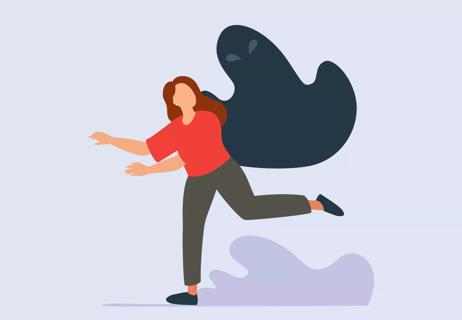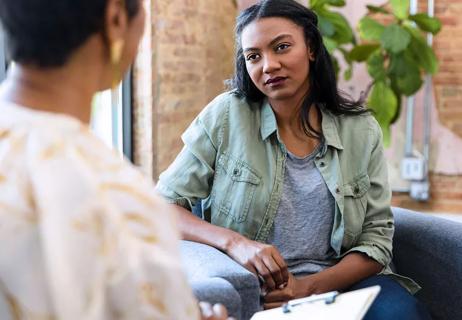Both include bouts of depression, but differ in their extremes

We all have our good days and bad days. Sometimes, even good months and bad months. Mood swings are nothing out of the ordinary.
Advertisement
Cleveland Clinic is a non-profit academic medical center. Advertising on our site helps support our mission. We do not endorse non-Cleveland Clinic products or services. Policy
But for people living with bipolar disorder, intense shifts in mood are a much different matter.
“There’s a distinct difference between bipolar disorder and our everyday mood swings,” says psychologist Lauren Alexander, PhD. “In people with bipolar disorder, episodes of depression and mania are more extreme and debilitating than the normal shifts in mood we all feel as part of being humans.”
Bipolar disorder is a chronic mental health condition that causes dramatic changes in mood, energy levels and behavior. Some people may refer to bipolar disorder by its former name, manic-depressive illness or manic depression.
There are four kinds of bipolar disorder:
When we think of bipolar disorder, it’s usually bipolar I and bipolar II that come to mind. These are the most common types.
Cyclothymic disorder is a milder form of bipolar disorder with less severe symptoms. And people with unspecified bipolar disorder experience symptoms similar to people living with other bipolar disorder types, but they don’t meet the full criteria.
We talked with Dr. Alexander about bipolar I and II to understand how these conditions are similar and how they’re different.
Advertisement
People with bipolar disorder I have severe and lasting episodes of both depression and mania. Between these extremes, you may return to a baseline (“normal”) mood state, knowns as euthymia. Euthymia can happen in both bipolar I and bipolar II.
“Everyone’s cycle is different,” says Dr. Alexander. “Some people rapidly cycle from depression into mania and don’t have any sort of baseline. But others do return to a level baseline for some time. Bipolar disorder is really quite variable in that regard.”
People with bipolar I experience periods of depression lasting at least two weeks and at least one episode of mania that lasts at least a week or that requires hospitalization.
Dr. Alexander adds that people with bipolar I often have a hard time maintaining significant relationships or remaining employed due to their condition.
During the depression phase of bipolar I, people experience a low mood, loss of interest in most activities, feelings of worthlessness and similar mood and behavior changes. Different from “feeling down” or sad, depression is a persistent state that can be debilitating.
Researchers say people with bipolar disorder tend to have more time in depressive episodes than in manic or hypomanic states.
In addition to episodes of depression, people with bipolar I experience cycles of mania.
Mania is a condition where you have an extremely elevated mood and high energy level. You may appear euphoric, irritable or impulsive. Mania can make people feel invincible. People experiencing mania may take part in risky behaviors, like gambling, driving recklessly, indulging in too much alcohol or using illicit drugs.
You also may experience a break from reality (psychosis). You may have delusions, like believing the government is watching you. Or hallucinations — seeing or hearing things that aren’t there. Some people experiencing mania may have a grandiose sense of self, believing they could join the NBA, though they have no basketball experience, or that they know the cure for cancer, though they have no medical or scientific training.
Manic symptoms can be dangerous, even life-threatening. People experiencing mania are often hospitalized during the course of a manic episode. That’s because mania can increase the likelihood of risky behaviors that leads to injury. Other times, people experiencing mania may engage in illegal acts and become hospitalized after being arrested. In some cases, people with mania are encouraged by others, like friends or family, to seek emergency medical attention because of their irrational thoughts or behaviors.
Advertisement
Bipolar II became a diagnosis separate from bipolar I in 1994. People living with bipolar II disorder also have bouts of depression that last at least two weeks. But they don’t experience mania. Instead, they experience hypomanic episodes. As with bipolar I, they may or may not experience a return to a baseline mood in between these more intense mood states.
People with bipolar II are more likely than people with bipolar I to hold steady employment and maintain healthy relationships.
As with bipolar I, people living with bipolar II experience episodes of depression that last at least two weeks. Some people with bipolar II may experience more chronic or debilitating episodes of depression than people with bipolar I.
People who live with bipolar II don’t experience episodes of mania. Instead, they experience cycles of depression and hypomania. Hypomania episodes are similar to manic episodes but aren’t as extreme. You may feel abnormally energetic, happy or excited. People with bipolar I may also experience episodes of hypomania, along with depression and mania.
People experiencing hypomania don’t have symptoms of psychosis, such as delusions or hallucinations. They may take risks or make hasty decisions, but not to the extent that people having a manic episode may. People having a hypomanic episode, for example, may make rash business investments, go on buying sprees or paint their whole house on a whim.
Advertisement
Manic episodes in people with bipolar I can be very dangerous and obvious. Hypomanic episodes, on the other hand, don’t typically stand out as much. They’re not something some people may initially recognize as being burdensome on their lives. So, they don’t seek treatment for them. For that reason, some people living with bipolar II are often initially diagnosed, or misdiagnosed, with depression, as those symptoms may be more likely to prompt them to seek medical attention.
Bipolar I and bipolar II each have specific criteria for diagnosis. And they affect your life in different ways.
| Bipolar I | Bipolar II | |
|---|---|---|
| Depression | Depression lasting at least two weeks. | Depression lasting at least two weeks. Tends to be longer lasting. |
| Mania | At least one episode of mania, lasting at least one week or requiring hospitalization. | No episodes of mania. |
| Hypomania | May present symptoms of hypomania. | Experiences symptoms of hypomania. |
| Psychosis symptoms | May experience delusions or hallucinations. | Does not experience delusions or hallucinations. |
| Hospitalization | May require hospitalization. | Does not require hospitalization. |
| Impact on daily life | Likely to interfere significantly with daily functions. | Lower impact on ability to manage daily functions. |
| Treatment | Common treatments include a combination of medication and therapy. Some people may require medication to treat symptoms specific to psychosis. | Common treatments include a combination of medication and therapy. |
| Depression | ||
| Bipolar I | ||
| Depression lasting at least two weeks. | ||
| Bipolar II | ||
| Depression lasting at least two weeks. Tends to be longer lasting. | ||
| Mania | ||
| Bipolar I | ||
| At least one episode of mania, lasting at least one week or requiring hospitalization. | ||
| Bipolar II | ||
| No episodes of mania. | ||
| Hypomania | ||
| Bipolar I | ||
| May present symptoms of hypomania. | ||
| Bipolar II | ||
| Experiences symptoms of hypomania. | ||
| Psychosis symptoms | ||
| Bipolar I | ||
| May experience delusions or hallucinations. | ||
| Bipolar II | ||
| Does not experience delusions or hallucinations. | ||
| Hospitalization | ||
| Bipolar I | ||
| May require hospitalization. | ||
| Bipolar II | ||
| Does not require hospitalization. | ||
| Impact on daily life | ||
| Bipolar I | ||
| Likely to interfere significantly with daily functions. | ||
| Bipolar II | ||
| Lower impact on ability to manage daily functions. | ||
| Treatment | ||
| Bipolar I | ||
| Common treatments include a combination of medication and therapy. Some people may require medication to treat symptoms specific to psychosis. | ||
| Bipolar II | ||
| Common treatments include a combination of medication and therapy. |
All forms of bipolar disorder can significantly disrupt your life, but treatment can help. Bipolar disorder is usually treated with a combination of therapy and medication.
But it’s common for people with bipolar disorder to have difficulty sticking with their treatment program. Particularly during periods of mania or hypomania, you may feel inclined to think you don’t need treatment.
“When the mania comes, it’s easy to think, ‘This is great. Maybe I don’t need the medication anymore, because I’m doing all right,’” Dr. Alexander states. “But often, it’s during episodes of mania that people are most at risk for getting very hurt.”
Advertisement
Stopping medication can cause severe side effects and trigger episodes of mania and depression, so keeping up your medication is important.
Dr. Alexander notes that suicidal ideation in people with bipolar disorder can happen during bouts of depression, as well as during episodes of mania.
“Many people think of suicide in association with depression, but completed suicides aren’t uncommon during mania,” Dr. Alexander notes. “That’s because mania accelerates impulsivity. And people can feel extremely miserable during a manic episode, despite how they may look to others.”
Seek immediate care for emergency situations, like thoughts of hurting yourself or others or having hallucinations or delusions. You can dial 988 if you or someone you know needs help.
Treatment for bipolar disorder is a lifelong commitment, and it can take time to find the treatment plan that best works for you, Dr. Alexander encourages. Staying committed to treatment is important. Building a trusted support group can help you stick with your treatment program.
Learn more about our editorial process.
Advertisement

Fishing for compliments, provoking conflict and pouring on the melodrama are all ways of expressing an unmet need

By setting boundaries around how much you give, you can save your time and resources while also being a good person

Certain B vitamins, omega-3 fatty acids and a healthy diet can serve as complementary treatments for schizophrenia

Following your treatment plan, finding a community, staying active and maintaining a healthy diet can help manage this psychiatric condition

Whether it’s playing hooky or faking cancer, malingering behavior is always motivated by personal gain

Causes range from psychological conditions like PTSD to physical conditions like fibromyalgia

Always putting others’ happiness before your own can build resentment over time

Emotional changes, isolation and unusual behavior could signal the onset of the condition

Babies can get congested easily, but you can calm their cough by keeping them hydrated, using nasal drops and running a humidifier

Weight loss may cause loose, sagging skin and muscle loss to your rear

Several conditions, like vitiligo and fungal infection, can cause a loss of pigmentation, leading to white spots or patches on your skin